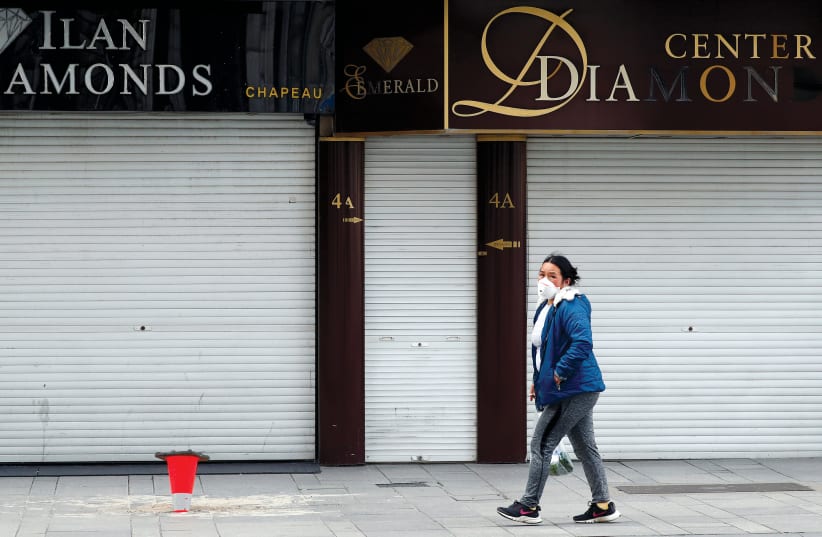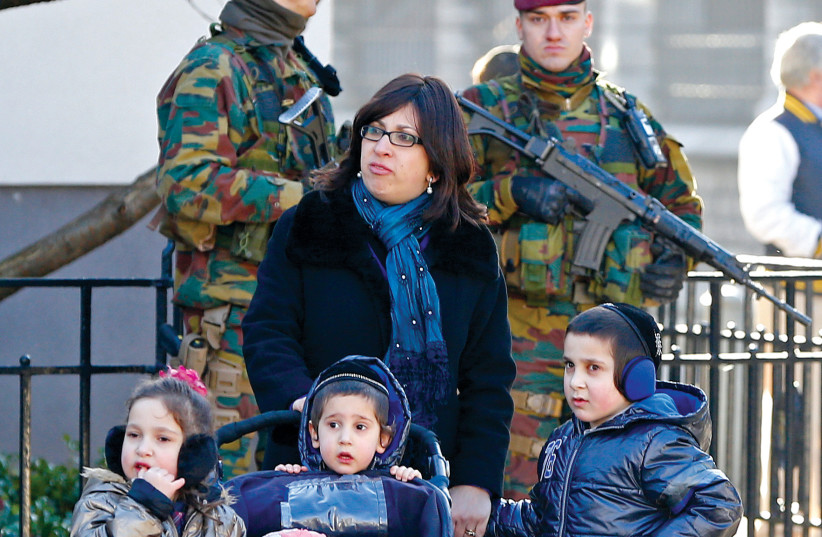Anyone who has watched the gripping crime series Rough Diamonds on Netflix, cannot fail to be intrigued. Rotem Shamir and Yuval Yefet’s outstanding drama is set in the Belgian city of Antwerp, in the heart of the diamond district, and in the heart of the haredi community. Aside from being completely riveted to the television screen throughout each episode, I was filled with nostalgic memories.
For over 40 years, I traveled to Belgium to work as an independent consultant. I would frequently go to Antwerp to find kosher places to eat after I’d finished work. The train ride from Brussels to Antwerp takes approximately 45 minutes. I have always been a curious traveler, using every opportunity to soak up my surroundings, wherever I happen to be. I recall my first train ride to Antwerp. For some reason, I found myself sitting on the right side of the train in a window seat. The last station before leaving Brussels for Antwerp is Brussels North.
In what looks like a very nondescript, not particularly interesting neighborhood, one suddenly notices a very bizarre spectacle as the train passes through the neighborhood of Schaerbeek and slows down before reaching the Brussels North Station. Most visitors are unprepared for what comes next, as a row of old houses with very large windows appears.
These houses are lit and framed by gaudy pink and purple neon lights. It doesn’t take much to realize that you are moving past the red-light district of Brussels, where scantily clad women, perched on the edge of their high chairs, provocatively display themselves to the passing pedestrian trade. A Belgian friend of mine once quipped that the train journey from Brussels to Antwerp was like going from hell to heaven!
The train moves on quite quickly and 40 minutes later approaches the Central Station, where it once again slows down and the view from the train window changes drastically. One suddenly finds oneself looking right into the large windows of a shtiebel (synagogue) where, depending on the time of day, you are likely to see a minyan (quorum of Jewish men) praying or sitting around a table studying Talmud.
The history of the haredi Jews of Antwerp, Belgium
In a 2018 census, it emerged that there were 20,000 haredi Jews living in Antwerp, of whom around 10,000 were hassidic. The haredi community resides mainly in the city center close to the main train station and close to the Diamond Bourse. All of this is dramatically captured in the Netflix series, where non-Jewish Belgian actors give stunning performances as they portray their Jewish characters.
They speak unbelievably convincing haredi Yiddish that can almost match the Yiddish of Dudu Fisher, who plays one of the lead characters. Most of the filming was done in the residential neighborhood of the diamond district, where 80% of the haredi community live.
On my first visit to Antwerp, I noticed that most of the ultra-Orthodox Jews lived in the city center and not in the suburbs. It reminded me of Roman Vishniac’s pre-war photographs of Jewish life in Eastern Europe. In the diamond district, the streets are quite narrow. There do not seem to be any balconies facing out onto the street, a reflection of the community’s need to protect their safety and privacy.
On some of my visits, I had to attend synagogue services in the evenings to say Kaddish. Finding the shuls was a nightmare. Despite being able to see the synagogues from the train windows, it was almost impossible to navigate the side streets and alleyways on foot. I had to follow and keep up with some of the haredim in their frock coats and black hats as they scurried off to shul.
Once at the synagogue, I remember entering a completely different world of high-ceilinged opulence with expensive wooden pews, a magnificent aron kodesh (Holy Ark), and crystal chandeliers. The congregants were friendly and welcoming to all, including those dressed as I was, in casual attire and wearing knitted (or crocheted) kippot.
For centuries, Antwerp’s Jews have played a prominent part in the diamond industry and have pretty much dominated it. In recent years, the mainstream non-haredi Jewish community has spread out to the suburbs or left Belgium altogether. On my many plane journeys from Tel Aviv to Brussels, I have sat next to Israelis and Belgian Jews who lament the decline of their communities in Antwerp and elsewhere.
Most of the non-haredi Jewish families in Antwerp have moved out to the suburbs, where they have enjoyed a very high standard of living. Over the past few decades, much of the wholesale diamond trade has been taken over by the Jain Indian community. With easy access to manufacturing centers in India, where production costs are significantly lower, the Jewish community has lost a great deal of its influence as far as the diamond trade is concerned.
These facts form the central plot of Shamir and Yefet’s fictional drama Rough Diamonds. Despite this, the diamond business remains a common profession shared by most of the members of the Jewish community. Many locals reflect on the demise of the diamond business both in Belgium and throughout the world. Unlike gold, the price of diamonds has significantly fallen – with the prognosis for 2023 being even more pessimistic.
“Younger people are not interested in these stones,” a prominent merchant told me. “They have lost their attraction as investment objects. The value of diamonds has dropped substantially because of lab-cultivated stones produced in Russia and elsewhere and the flooding of the rough diamond market from Africa.”
On top of everything else, Belgium has become a country that is no longer as welcoming to Jews as it once was. The history of Jewish life in Antwerp goes back at least 800 years. More recently, the Flemish-speaking Belgians were considered Aryans by the Nazis, and many collaborated with the German authorities when they occupied Belgium in 1940. Prior to this, there were 35,000 Jews living in the city. After liberation in 1944, there were only 1,200 Jews left.
In my early years of visiting Antwerp a few decades ago, I noticed that most of the Jews spoke French and not Flemish. They seemed to identify more with the Walloons, the French-speaking Belgian population. Today, most of the haredim speak Yiddish and Flemish and not French. They prefer Flemish because, like Dutch, it is a Germanic language more akin to Yiddish. Belgium today is still a very divided cultural entity.
The two communities of French- and Flemish-speaking people are split culturally, linguistically, and politically. There was a time when the French speakers dominated politically and economically. The Flemish always felt that they were treated as second-class citizens. Nowadays, the opposite is true. The Flemish Belgians have become the dominant economic force in the country.
Over the past few decades, antisemitism has become rife again in the country. The year 2014 marked an increased frequency of antisemitic attacks. In July 2014, a doctor refused to care for Holocaust survivor Bertha Klein, telling her son, “Send her to Gaza for a few hours, then she will get rid of the pain. I’m not coming.”
The incident was ranked as the worst antisemitic incident in 2014 by the Simon Wiesenthal Center.
In January 2019, Flanders banned the kosher and halal slaughter of animals. In the same year, a parade float featuring stereotyped Jewish figures at a carnival near Brussels was widely condemned as antisemitic. It featured grinning figures of haredi Jews standing on large piles of money. Belgian-Jewish journalist Cnaan Liphshiz recently wrote that “What is most troubling about the current state of antisemitism in Belgium is the fact that officials and opinion-shapers have often defended the perpetrators of antisemitic incidents on the grounds of ‘free speech’ or that no offense was supposedly intended.”
According to Liphshiz, “classic antisemitism” of a type he had thought “impossible in an established Western democracy in the heart of Europe” is now “mainstream” in Belgium. It is little wonder, then, that so many Belgian Jews are making aliyah or have made aliyah in large numbers.
“If they are not making aliyah, they are investing in real estate in Israel as a necessary precaution to what might yet happen in the future,” my Belgian colleague told me.
After watching Rough Diamonds, I couldn’t help pondering the question: Had the creators Shamir and Yefet given any consideration to the consequences that their drama might have in stoking the fires of the already smoldering antisemitism in Belgium and elsewhere? Or were they relying on the officials and opinion-shapers in Belgium on the grounds of “freedom of expression” with no offense implied or intended? ■

